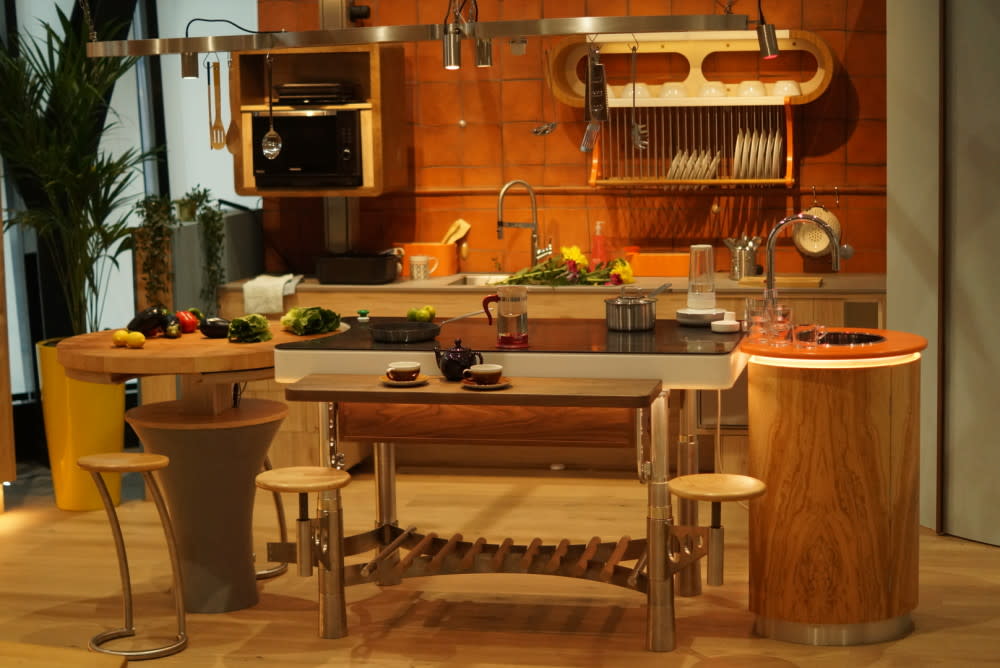World renowned designer, Johnny Grey, and expert in ageing, Peter Gore have turned their vision for kitchens of the future into reality at Newcastle Helix.
The 4 Gen kitchen has been designed to meet needs across the life course, from young children to older adults and everything in-between.
Using innovative technology and world-class design, Johnny Grey and Professor Peter Gore have created a kitchen which is not only practical and safe for all ages but also a kitchen that can become the heart of a home.
A fully working prototype of the 4Gen Kitchen has now been installed at the UK National Innovation Centre for Ageing in Newcastle upon Tyne.
Multigenerational homes
Across the world a growing number of homes are becoming “multigenerational.” Grey and Gore have collaborated to create a kitchen that flexes and adapts to meet the different needs of different ages.
Professor Gore explained: “One of the ways we have approached the design process is to eliminate some of the risks and problems that occur in normal kitchen designs. Part of assuring accessibility to a kitchen is to manage the risks faced by the different potential users.”
Features built into the design include warnings and safety features to protect both younger and older users.
The floor, for example, is able to detect spills. The kitchen will then provide an audible warning, change the colour of LED lighting to warn users of the slip hazard, and isolate the water until the problem is addressed.
Access to different devices and drawers adjusts depending on who is in the room. A child in the room on their own, for example, can be prevented from opening a drawer containing knives.
As well as safety features, the height of key areas and appliances can adjust to different users’ needs. The oven, preparation area and even the sink are all height adjustable to ensure access for children, wheelchair users and adults of all ages.
User-led design
Started in 2017, the 4Gen Kitchen project undertook intensive user research to gain a deep understanding of the unmet needs of multigenerational families.
The VOICE network was key to the user research. VOICE is a diverse, thriving international network of citizens of all ages and is part of the UK National Innovation Centre for Ageing (NICA). The members share their insights, vision and experiences to support a wide range of market research and design challenges.
“Harnessing our collective intelligence, we call it Ageing Intelligence® , is essential to help us understand and deliver on what is needed both now and in the future” said Professor Lynne Corner, Director of Voice and NICA’s Chief Operating Officer.
Professor Gore explained: “Rather than focussing on why people have problems, we focussed on the problems people have. This gave us the insight that we needed to move to the design stage.”
With funding from the Northern Accelerator scheme, the team was able to progress to designing a kitchen for a multigenerational home.
Grey, a prominent name in kitchen design since the 1980s, said: “We wanted to make the kitchen welcoming, not just for people who are older, but for everyone.
“I think this kitchen shows something slightly different, the items are beautiful, yet functional. The furniture is very flexible and it’s responsive – it can behave in a way which works well for you and your family. It’s about a living space, much more than just a kitchen.”
Key features
- Smart ‘cooking anywhere’ induction surface with the newest, safe cooking technology. Hidden embedded appliance powering – no leads
- Working table with linked circular preparation counter
- Multiple rise and fall countertops
- ‘Soft edges’ wall cupboards from carbon neutral, lightweight, fireproof materials
- Soft geometry walk-in pantry for visual clarity of stored items and easy access
- Memory era inspired wallpaper designs for comfort and style
Progressing from smart to intelligent
A key aspect of the kitchen is that it goes beyond “smart” to “intelligent” use of technology.
Gore explained: “Smart technology can connect many aspects of a home. Using Amazon Echos to control our lights is a common example. The difference in this kitchen is that it uses smart technology and then applies intelligence to ensure everybody remains safe.
“Extending the Amazon Echo example, the kitchen’s operating system can adjust what can and can’t be commanded by different users with different abilities and appropriate constraints.”
The future of our homes, not just our kitchens
Although the prototype that has been built is a kitchen, there is potential to influence how we think about and use all the different spaces in homes.
Gore said: “You can often find examples of homes that are designed and built with a specific age group in mind such as homes for older people, or apartments targeted at young professionals. We think there is potential to shift design and construction away from thinking about building properties for just one or two generations toward building for multigenerational homes.
“There is potential too to rethink how we use and work with appliances in our home. In our prototype, we’ve tried to open the door to exploring the future of AI, monitoring and IoT throughout our homes.”
Arrange a virtual viewing of the kitchen prototype
Unfortunately owing to Covid-19 restrictions, it is not possible to visit the prototype in person. But you are able to complete virtual viewing.
To arrange an opportunity to view, discuss and feedback on the prototype, please contact Lynda Speed, Business Development Manager at Newcastle University.
Originally posted on: Newcastle Helix


